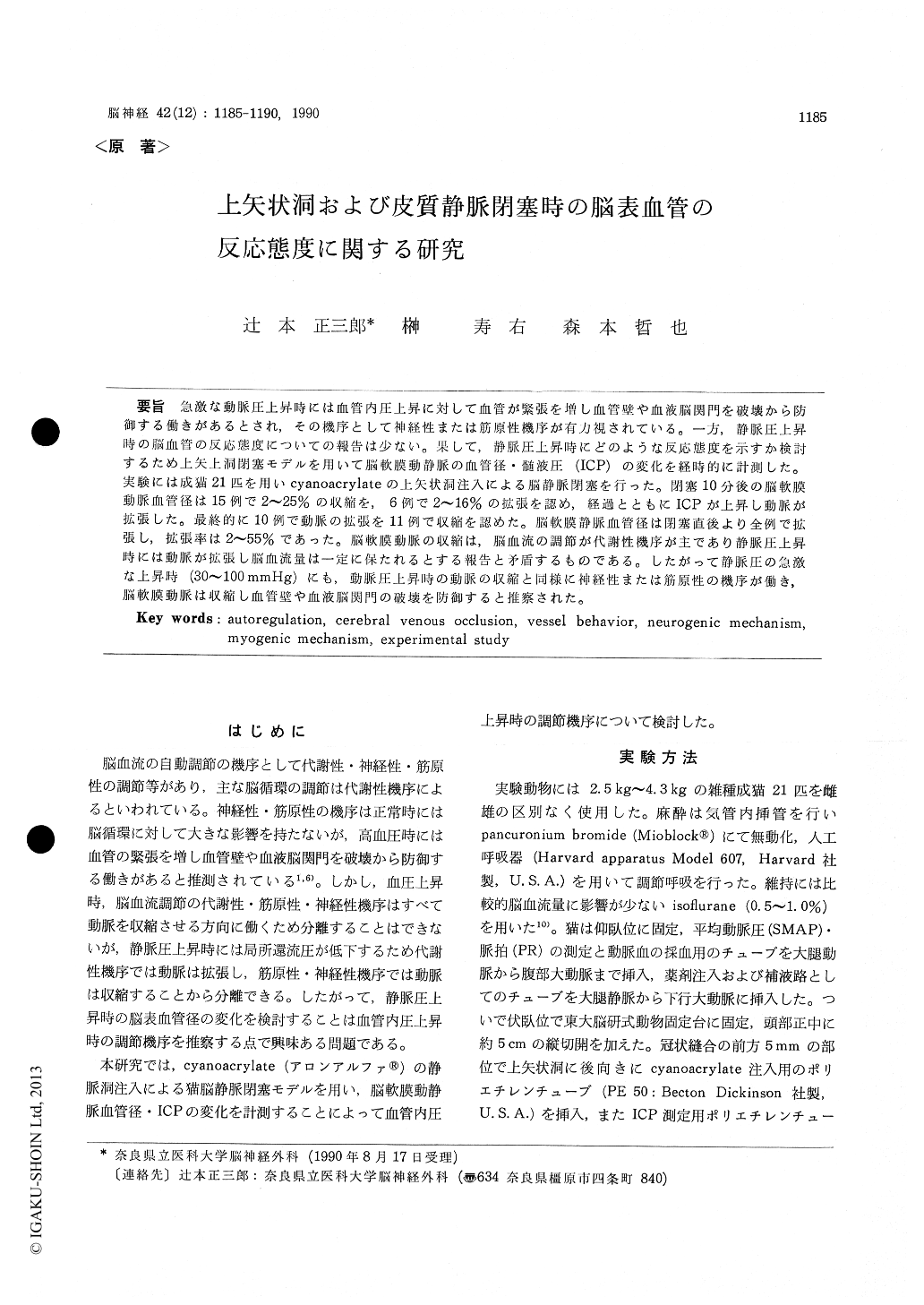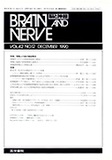Japanese
English
- 有料閲覧
- Abstract 文献概要
- 1ページ目 Look Inside
急激な動脈圧上昇時には血管内圧上昇に対して血管が緊張を増し血管壁や血液脳関門を破壊から防御する働きがあるとされ,その機序として神経性または筋原性機序が有力視されている。一方,静脈圧上昇時の脳血管の反応態度についての報告は少ない。果して,静脈圧上昇時にどのような反応態度を示すか検討するため上矢上洞閉塞モデルを用いて脳軟膜動静脈の血管径・髄液圧(ICP)の変化を経時的に計測した。実験には成猫21匹を用いcyanoacrylateの上矢状洞注入による脳静脈閉塞を行った。閉塞10分後の脳軟膜動脈血管径は15例で2〜25%の収縮を,6例で2〜16%の拡張を認め,経過とともにICPが上昇し動脈が拡張した。最終的に10例で動脈の拡張を11例で収縮を認めた。脳軟膜静脈血管径は閉塞直後より全例で拡張し,拡張率は2〜55%であった。脳軟膜動脈の収縮は,脳血流の調節が代謝性機序が主であり静脈圧上昇時には動脈が拡張し脳血流量は一定に保たれるとする報告と矛盾するものである。したがって静脈圧の急激な上昇時(30〜100mmHg)にも,動脈圧上昇時の動脈の収縮と同様に神経性または筋原性の機序が働き,脳軟膜動脈は収縮し血管壁や血液脳関門の破壊を防御すると推察された。
In cerebral circulation, it is suspected that neuro-genic or myogenic mechanism protect blood vessel and blood-brain barrier during sudden increase in arterial pressure. To discriminate metabolic me-chanism from neurogenic and myogenic mecha-nism, complete cerebral venous occlusion model of cat was used to obtain high venous pressure. In twenty-one anesthetized cats, 0.3 ml of cyanoacry-late were injected into anterior part of SSS to oc-clude SSS and cortical vein. Diameter of pial ves-sels and ICP were measured through the cranial window.
An average of ICP was 6.7±1.8 mmHg before occlusion. 5 minutes after occlusion ICP was ele-vated to an average of 10.4±4.8 mmHg. Finally, ICP increased over 20 mmHg in nine animals. All pial vein dilated immediately after injection of cyanoacrylate and the dilatation rate was 2-55%. Pial arteriole between 50 μm and 100 μm in dia-meter was observed. In early stages, 2-24% con-traction of arteriole were observed in fifteen ani-mals and 2-16% dilatation were observed in six animals. In later stages, 1-87% dilatation of arte-riole were observed in ten cats. Ten of twelve (83%) cases with ICP under 20 mmHg showed con-traction of pial arteriole. Eight of nine (89%) ca-ses with ICP over 20 mmHg showed dilatation of pial arteriole. In addition, the elevation of ICP and the dilatation of pial arteriole were observed simultaneously. Correlation between ICP and ar-terial diameter is obvious.
The dominant mechanism of cerebral blood flow control is metabolic, not neurogenic and myogenic. Increase of ICP, dilatation of vein and dilatation of artery with increasing ICP are consistent with the theory. But the contraction of arteriole can-not be explained. In ordinary state, capillary in-travascular pressure is about 30 mmHg. Assuming that the vein is occluded completely and there are no collateral circulation, precapillary intravascular pressure shows 100-110 mmHg (systemic arterial pressure). But there exist collateral circulation so precapillary intravascular pressure indicate bet-ween 30 mmHg to 100 mmHg.
Consequently with very high cerebral venous pressure (transmural pressure), more than 30-100 mmHg, pial arteriole contracts, though the region-al cerebral blood flow decreases. It is said that neurogenic or myogenic mechanism protect blood vessel and blood-brain barrier during sudden incr-ease in arterial pressure. Similarly, it is suspected that on very high venous pressure neurogenic or myogenic mechanism functions strongly so pial ar-teriole contracts.

Copyright © 1990, Igaku-Shoin Ltd. All rights reserved.


